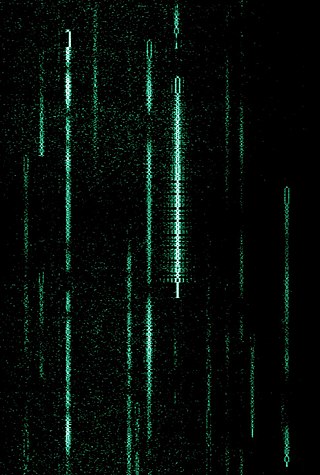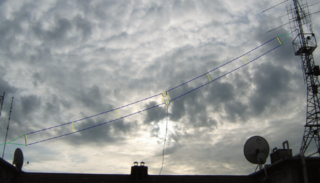Related Research Articles

Enhanced Data rates for GSM Evolution (EDGE), also known as 2.75G, Enhanced GPRS (EGPRS), IMT Single Carrier (IMT-SC), and Enhanced Data rates for Global Evolution, is a 2G digital mobile phone technology for data transmission. It is a subset of General Packet Radio Service (GPRS) on the GSM network and improves upon it offering speeds close to 3G technology, hence the name 2.75G. It is also recognized as part of the International Mobile Telecommunications - 2000 (IMT-2000) standard.

Morse code is a telecommunications method which encodes text characters as standardized sequences of two different signal durations, called dots and dashes, or dits and dahs. Morse code is named after Samuel Morse, one of the early developers of the system adopted for electrical telegraphy.

Radioteletype (RTTY) is a telecommunications system consisting originally of two or more electromechanical teleprinters in different locations connected by radio rather than a wired link. Radioteletype evolved from earlier landline teleprinter operations that began in the mid-1800s. The US Navy Department successfully tested printing telegraphy between an airplane and ground radio station in 1922. Later that year, the Radio Corporation of America successfully tested printing telegraphy via their Chatham, Massachusetts, radio station to the RMS Majestic. Commercial RTTY systems were in active service between San Francisco and Honolulu as early as April 1932 and between San Francisco and New York City by 1934. The US military used radioteletype in the 1930s and expanded this usage during World War II. From the 1980s, teleprinters were replaced by personal computers (PCs) running software to emulate teleprinters.

The R-S-T system is used by amateur radio operators, shortwave listeners, and other radio hobbyists to exchange information about the quality of a radio signal being received. The code is a three digit number, with one digit each for conveying an assessment of the signal's readability, strength, and tone. The code was developed in 1934 by Amateur radio operator Arthur W. Braaten, W2BSR, and was similar to that codified in the ITU Radio Regulations, Cairo, 1938.

PSK31 or "Phase Shift Keying, 31 Baud", also BPSK31 and QPSK31, is a popular computer-sound card-generated radioteletype mode, used primarily by amateur radio operators to conduct real-time keyboard-to-keyboard chat, most often using frequencies in the high frequency amateur radio bands (near-shortwave). PSK31 is distinguished from other digital modes in that it is specifically tuned to have a data rate close to typing speed, and has an extremely narrow bandwidth, allowing many conversations in the same bandwidth as a single voice channel. This narrow bandwidth makes better use of the RF energy in a very narrow space thus allowing relatively low-power equipment to communicate globally using the same skywave propagation used by shortwave radio stations.

The Tilted Terminated Folded Dipole or Balanced Termination, Folded Dipole (BTFD) - also known as W3HH antenna - is a general-purpose shortwave antenna developed in the late 1940s by the United States Navy. It performs reasonably well over a broad frequency range, without marked dead spots in terms of either frequency, direction, or angle of radiation above the horizon.
The Maidenhead Locator System is a geocode system used by amateur radio operators to succinctly describe their geographic coordinates, which replaced the deprecated QRA locator, which was limited to European contacts. Its purpose is to be concise, accurate, and robust in the face of interference and other adverse transmission conditions. The Maidenhead Locator System can describe locations anywhere in the world.
The 10-meter band is a portion of the shortwave radio spectrum internationally allocated to amateur radio and amateur satellite use on a primary basis. The band consists of frequencies stretching from 28.000 to 29.700 MHz.
Multiple frequency-shift keying (MFSK) is a variation of frequency-shift keying (FSK) that uses more than two frequencies. MFSK is a form of M-ary orthogonal modulation, where each symbol consists of one element from an alphabet of orthogonal waveforms. M, the size of the alphabet, is usually a power of two so that each symbol represents log2 M bits.
The C0 and C1 control code or control character sets define control codes for use in text by computer systems that use ASCII and derivatives of ASCII. The codes represent additional information about the text, such as the position of a cursor, an instruction to start a new line, or a message that the text has been received.
UTF-1 is an obsolete method of transforming ISO/IEC 10646/Unicode into a stream of bytes. Its design does not provide self-synchronization, which makes searching for substrings and error recovery difficult. It reuses the ASCII printing characters for multi-byte encodings, making it unsuited for some uses. UTF-1 is also slow to encode or decode due to its use of division and multiplication by a number which is not a power of 2. Due to these issues, it did not gain acceptance and was quickly replaced by UTF-8.
AMTOR is a type of telecommunications system that consists of two or more electromechanical teleprinters in different locations that send and receive messages to one another. AMTOR is a specialized form of RTTY protocol. The term is an acronym for Amateur Teleprinting Over Radio and is derived from ITU-R recommendation 476-1 and is known commercially as SITOR developed primarily for maritime use in the 1970s. AMTOR was developed in 1978 by Peter Martinez, G3PLX, with the first contact taking place in September 1978 with G3YYD on the 2m Amateur band. It was developed on homemade Motorola 6800-based microcomputers in assembler code. It was used extensively by amateur radio operators in the 1980s and 1990s but has now fallen out of use as improved PC-based data modes are now used and teleprinters became out of fashion.
T.51 / ISO/IEC 6937:2001, Information technology — Coded graphic character set for text communication — Latin alphabet, is a multibyte extension of ASCII, or more precisely ISO/IEC 646-IRV. It was developed in common with ITU-T for telematic services under the name of T.51, and first became an ISO standard in 1983. Certain byte codes are used as lead bytes for letters with diacritics. The value of the lead byte often indicates which diacritic that the letter has, and the follow byte then has the ASCII-value for the letter that the diacritic is on.

A quad antenna is a type of directional wire radio antenna used on the HF and VHF bands. A quad is a Yagi–Uda antenna ("Yagi") made from loop elements instead of dipoles: It consists of a driven element and one or more parasitic elements; however in a quad, each of the loop elements may be square, round, or some other shape. It is used by radio amateurs on the HF and VHF amateur bands.
WSJT-X is a computer program used for weak-signal radio communication between amateur radio operators. The program was initially written by Joe Taylor, K1JT, but is now open source and is developed by a small team. The digital signal processing techniques in WSJT-X make it substantially easier for amateur radio operators to employ esoteric propagation modes, such as high-speed meteor scatter and moonbounce. Additionally WSJT is able to send signal reports to spotting networks such as PSK Reporter.
An amateur radio propagation beacon is a radio beacon, whose purpose is the investigation of the propagation of radio signals. Most radio propagation beacons use amateur radio frequencies. They can be found on LF, MF, HF, VHF, UHF, and microwave frequencies. Microwave beacons are also used as signal sources to test and calibrate antennas and receivers.

The Moxon antenna or Moxon rectangle is a simple and mechanically rugged two-element parasitic array, single-frequency antenna. It takes its name from the amateur radio operator and antenna handbook author Les Moxon.

OpenLisp is a programming language in the Lisp family developed by Christian Jullien from Eligis. It conforms to the international standard for ISLISP published jointly by the International Organization for Standardization (ISO) and International Electrotechnical Commission (IEC), ISO/IEC 13816:1997(E), revised to ISO/IEC 13816:2007(E).
ISO/IEC 10367:1991 is a standard developed by ISO/IEC JTC 1/SC 2, defining graphical character sets for use in character encodings implementing levels 2 and 3 of ISO/IEC 4873.
PSAT-2 is an experimental amateur radio satellite from the U.S. Naval Academy, which was developed in collaboration with the Technical University of Brno in Brno, Czech Republic. AMSAT North America's OSCAR number administrator assigned number 104 to this satellite; in the amateur radio community it is therefore also called Navy-OSCAR 104, short NO-104.
References
- ↑ Steven L Karty, N5SK. "PSK31 Spec". ARRL Website. Retrieved 18 Dec 2010.
{{cite web}}: CS1 maint: numeric names: authors list (link) - ↑ Peter Martinez, G3PLX. "PSK31: A New Radio-Teletype Mode" (PDF). Retrieved 28 Sep 2017.
{{cite web}}: CS1 maint: numeric names: authors list (link) - ↑ ITU Working Party 5A. "ITU-R M.2034: Telegraphic Alphabet for Data Communication by Phase Shift Keying at 31 Baud in the Amateur and Amateur-Satellite Services". International Telecommunication Union (approved Feb, 2013). Retrieved 21 Feb 2013.
{{cite web}}: CS1 maint: numeric names: authors list (link)